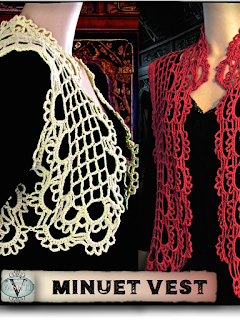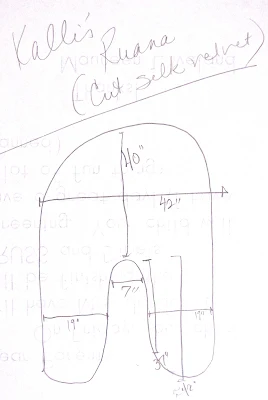 |
| Kimono and ruana cartoons from my sketchbooks |
Also, some diagrams in the newsletter were too small for some people's browsers, so I've reproduced higher-res images of them here. Just click on one to see it fully enlarged.
The ease and versatility of kimono and ruana shapes for crochet (as described in the newsletter) is such a rich topic that even the overflow from a newsletter issue is too much for a blog post!
 |
| Alzannah is a ruana. |
In the cartoons below, compare the seemingly minor variations in front and neck opening shapes. These are only a fraction of the very meaningful variations possible with this shape.
Add to this that there are several other versatile simple shapes that also underlie many seemingly complex garments. I'm just mentioning this because today's blog topic is a mere taste of the cool stuff to consider when designing crochet clothing.
Here are images in the newsletter that some people had a hard time seeing clearly enough. I hope these help:
 |
| See issue #41 for explanations of these two sets of 'cartoons'. Remember that you can click on a photo to make it full size in all its cartoony glory. |
You know what's funny to me? A few newsletter readers here and there have told me that I give away too much information in them. Sometimes I think it's from concern for my business and intellectual property, and I appreciate that, but I always see it as a good thing. GREAT, even. Can you imagine how awful the opposite would be?! (I can, because a few 'newsletters' I get are really just fancy advertising spam. They give nothing.)
 |
| Minuet Vest actually starts out as a ruana. |
Schematics are powerful tools if you know how to use them. It has taken me years--years!--to see everything there is to see in a schematic. For those readers who can get the most from one of the above cartoons, go for it! I'm not giving too much away; you've earned it, and your final design will be different from the ones I "see" when I look at these sketches.
Not only that, the schematics above are missing measurements. That's when the real work of using a schematic begins, anyway. For crocheters who are new to the powers of a schematic, I offer tips in the newsletter for starting out on your own journey of gaining wisdom about them. For example, use the schematics in the patterns you already own, and experiment with them for your own personal use. Try putting your foundation row along a different edge of the shape and see what you think. If you have store bought kimonos or ruanas, measure them and analyze what you like about them. You will gain so much from this!
 |
| (I know it's faint, sorry. It's even less clear if I darken it.) |
Now here's an actionable, valuable schematic because it has measurements. Am I giving away too much? I don't think so...heck, it doesn't even inspire me anymore!
Try as I might, I no longer recall what the actual garment looked like. I should have taken a photo or sketched its shape on Kalli while she wore it--whatever it was that made me go to the hurried trouble to measure and sketch it at all.
See, over the years I've also learned what to include in a sketch to give its inspiration staying power.
But if this cartoon inspires you, great. I'm glad you got something out of visiting my blog today! If you crochet one, I'd love to see a picture.

Funny that people say you reveal too much in your posts - I think it's great that you let us see the bones of your designs. Thanks! This is very inspiring.
ReplyDeleteThe more you give away the more comes back to you! Besides, nobody will ever use the information in the same way as you do - if they use it at all. Write on! (And get going on that book...)
ReplyDeleteThank you :-)
ReplyDelete